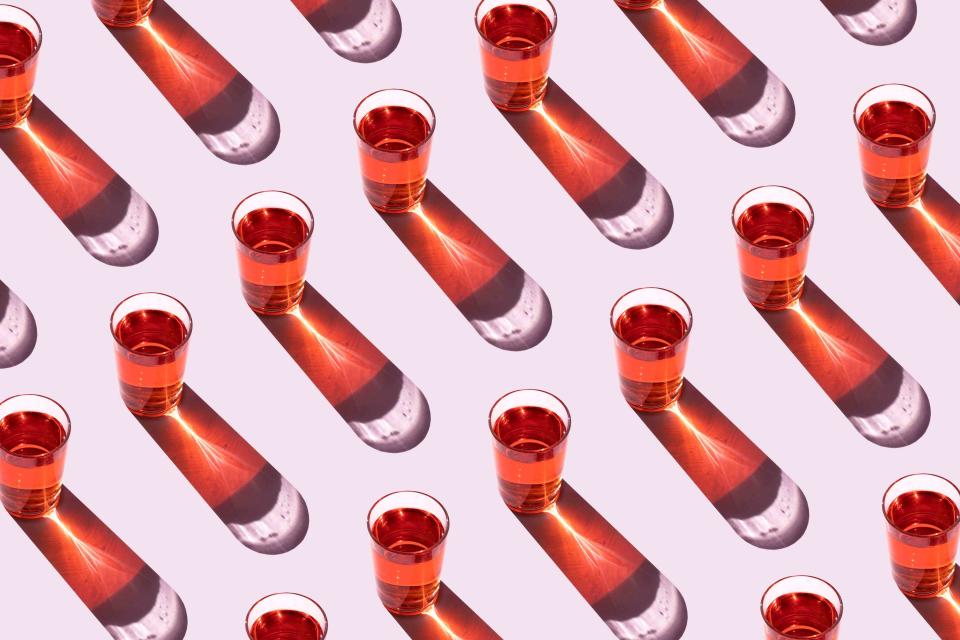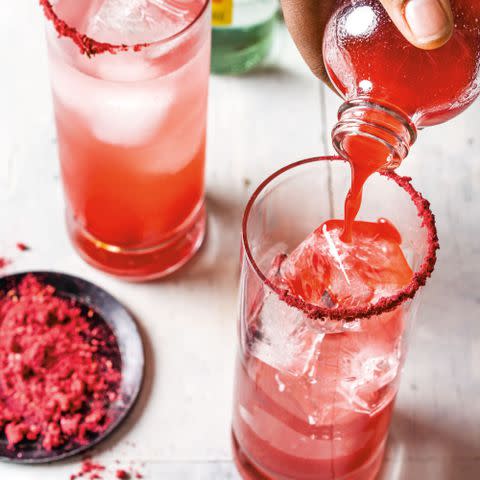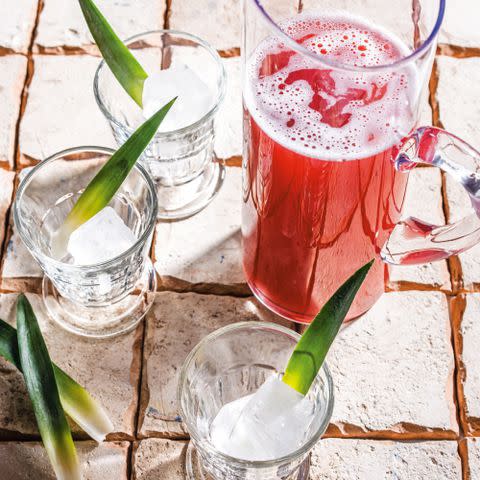How Red Drink Became the Official Beverage of Juneteenth
From West African red-colored teas made with ingredients like hibiscus petals and kola nuts to Big Red Soda, red drink has a long, rich history.

Getty Images
Red drink, also known as “red drank,” is Juneteenth’s official beverage. This comes as no surprise: Red drinks have long lubricated the social gatherings of West Africans and people of African heritage in the Americas, particularly those celebrating emancipation from slavery. The type of red drink varies, the only constant being that the liquid being consumed has a red hue. I know what you’re thinking. Please gently put aside any jokes that comedian Dave Chappelle has made about the primacy of “purple drank.” Forget as well what anyone under 30 may say about blue drinks, orange drinks, or any other drinks of color. As soul food aficionados know, red is a color and a flavor. African Americans don’t obsess on whether the key ingredient is cherry, cranberry, hibiscus, raspberry, strawberry, or tropical fruit, as long as the drink in question has the correct color. When it comes to emancipation celebrations, it’s all about red, baby!
Related: 23 Recipes to Celebrate Juneteenth
Juneteenth is an emancipation celebration that commemorates the day when on June 19, 1865, two and a half years after the Emancipation Proclamation went into effect, Major General Gordon Granger, Commanding Officer of the Union Army for the District of Texas, arrived in Galveston and read "General Order No. 3." The order states: "[T]he people of Texas are informed that, in accordance with a proclamation from the executive of the United States, all slaves are free ...”. Originally, the events later held on this auspicious day were called "the 19th of June" or the "June 19th" celebration. By the 1910s, people inside and outside of Texas called this special day "Juneteenth." After years of lobbying, the state of Texas recognized Juneteenth as an official state holiday in 1980. Though Juneteenth started out in Texas, migrating Texans transplanted the celebration all across the nation. Thanks to their outsized Texas boosterism, Juneteenth became a federal holiday in 2021. Yet, one should understand that despite its current pre-eminence, Juneteenth is just one of a number of African American emancipation celebrations rooted in local history and tradition.
Related: Juneteenth Means Celebrating the Fruits of Our Labor
Why are red drinks linked with Emancipation celebrations? No one knows for sure, but West African hospitality traditions provide some clues. Before and after European contact, West Africans welcomed and entertained their household guests with red-colored beverages — more accurately described as teas — made from hibiscus flower petals or kola nuts, which are indigenous to that part of Africa. These drinks had such strong cultural resonance that these botanical ingredients crossed the Atlantic Ocean with humans in bondage. Additionally, it’s widely believed that the color red symbolically represents the blood shed by enslaved African ancestors.

Ed Anderson
As I wrote in my book, Soul Food: The Surprising Story of an American Cuisine, One Plate at a Time, red drinks were plentiful in the antebellum South. The oral histories of the enslaved and Southern cookbooks are replete with numerous references and recipes for hard and soft red drinks made from fresh fruit, liqueurs, syrups, and vinegars. For example, the earliest known African American-authored cookbook, The Domestic Cook Book by Mrs. Malinda Russell, which was published in 1866, includes a strawberry cordial recipe. (In case you’re wondering, cordials are adult beverages that typically combine fruit juice, sugar, and brandy.) Any time a group of people of African heritage gathered in the Americas, and were free to decide what to drink, a red-colored beverage was a consistently popular choice. When Emancipation became a reality, red drinks were a natural selection.
Over time, African American Emancipation celebrations featured a progression of red drinks. Molasses and water was an early favorite before Juneteenth celebrations began. This one may seem like a head-scratcher, since most of the molasses one sees these days is a very dark brown. Yet, the initial batch of molasses made from crushing sugar cane and extracting its juice varies in color from red to amber. When further boiled, the molasses gains a more familiar, darker color, and that’s what is often sold to consumers. Free and enslaved field workers celebrated molasses and water as a refreshing, energy-boosting drink. Because molasses was widely available and cheap, it became a popular drink. Though we don’t know for sure, a plentiful amount of oral history from the enslaved suggests that the molasses used for beverages was red.
Molasses and water was a favorite at Emancipation celebrations in South Carolina, which were some of the earliest observed in the waning days of the Civil War. The concoction was served on January 1, 1863, which was simultaneously celebrated as New Year’s Day and Emancipation Day in Port Royal, South Carolina. In a letter written that same day, a missionary named Harriet Ware noted that African Americans and Union Army troops gathered on the John Joyner Smith plantation near Beaufort, South Carolina, and the Emancipation Proclamation was read aloud. Afterwards, the assembled enjoyed “twelve roasted oxen (barbecue), hard bread, and molasses and water.”
While molasses and water got the spotlight in South Carolina, red lemonade was by far the crowd favorite in other locales, according to the newspaper reports of the Emancipation celebrations held during the latter decades of the 19th century. The lemonade was colored red by the addition of pureed fruit or syrup made from ingredients like cherries, raspberries, strawberries, or sumac. Others just added food coloring. Red lemonade had previously owed much of its popularity to its association with the circus, a wildly beloved entertainment amongst African Americans at the time. (For this reason, red lemonade was commonly called “circus lemonade.”) As just one example of its appearance at Juneteenth celebrations, in 1897, a small-town newspaper in Missouri called the Marceline Journal-Mirror reported that “[w]atermelon, spring chicken, and red lemonade took the park” at a late August Emancipation anniversary celebrated by the community’s “colored friend and brother.”
Related: Boozy Frozen Strawberry Lemonade
The turn of the 20th century saw a carbonated beverage craze thanks to marked improvements in bottling technology. Now, one could enjoy a “soda water,” “soda pop,” or “pop” anywhere they wanted rather than being confined to a brick-and-mortar soda fountain. Keeping with tradition, Juneteenth revelers switched from red lemonade to gulping down gallons of red-colored carbonated beverages. At a 1934 Juneteenth celebration in Hope, Arkansas, (birthplace of future U.S. president Bill Clinton), “barbecued meats, red soda pop, ice cream and cake were served in generous quantities.” In the 1960s, Waco, Texas-based Big Red Soda somehow became — and remains — the de facto Juneteenth beverage of choice in the Lone Star State. (Maybe it was all because of the name.) The drink had been around since 1937, but its manufacturer previously called it “Sun Tang Red Cream Soda.” For Texans, and those heavily influenced by Texans, Big Red soda is still synonymous with Juneteenth.

Ed Anderson
We’re currently living through exciting times for red drink, as the Juneteenth menu has expanded. Some are taking red drink “back to the future” by returning traditional West African beverages, notably hibiscus drinks, to the forefront. In 2022, Sunyatta Amen, a fifth-generation expert herbalist and owner of Calabash Tea & Tonic in Washington, D.C., advocated for hibiscus drinks as a great option for Juneteenth in a Washington Post article. Under the auspices of her “Your Resident Gourmet” brand, chef Jennifer Booker sells a powdered hibiscus lemonade mix that she calls “Juneteenth Jubilee Punch.”
In her 2023 book Flavor+Us: Cooking for Everyone, chef Rahanna Bisseret Martinez includes two hibiscus-based red drinks. Her Jamaica and Pineapple Punch is composed of dried hibiscus, fresh pineapple, lime juice, and agave syrup (“Jamaica” is another name for hibiscus, nodding to hibiscus’ long association with the island nation of Jamaica), while her Sharab Rose Raspberry Shrub points both to the Middle East and to the Southern plantation tradition of the shrub: vinegary and pungent drinks which could have had a place at 19th-century Juneteenth celebrations.
I personally can’t wait for the next iteration of red drink. (As long as they are actually red and not served in rose colored glasses!) In the meantime, if you’re thinking of getting a red drink soon, here are suggestions on pairing some great red drinks with your favorite foods.
For spicy foods, I recommend a fresh agua de Jamaica. It’s floral and foxy with hints of cranberry.
Barbecue calls for a red drink with a big personality. I suggest the effervescence of a Big Red soda born from the terroir of Waco, Texas. It has the crisp structure of red berries, with undertones of cotton candy.
For anything else, I recommend a red (Tropical Punch) Kool-Aid. The attack on the nose is vigorous without being overbearing. The true connoisseur doesn’t object to the proper sweetness, especially when there is a great aftertaste. Naturally, it must be consumed from a jelly jar.
Adrian Miller is a James Beard Award-winning writer and the official cheerleader for red drink.
For more Food & Wine news, make sure to sign up for our newsletter!
Read the original article on Food & Wine.


